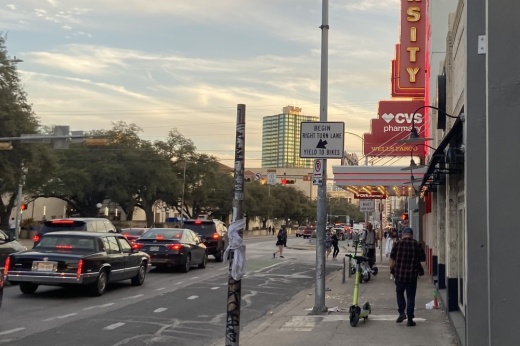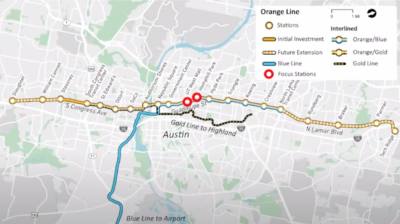In 2020, Austin voters approved Project Connect, a $7.1 billion mass-transit system with new bus and rail lines. The Orange Light rail line running between Stassney Lane and the North Lamar Transit Center will go directly through The Drag with a stop at UT West Mall. Plans call for a future extension south to the Slaughter Transit Center and north to the Tech Ridge Transit Center.
At a community meeting for The Drag June 14, Project Connect officials announced another design option without vehicular traffic.
“The Drag is one of the iconic places in our city,” said Peter Mullan, Austin Transit Partnership chief of architecture and urban design. “It epitomizes and embodies so many of the things that make Austin, Austin and give it its character.”
The newly proposed Option C would remove vehicular traffic on Guadalupe Street between 22nd and 29th streets, with an additional lane for buses and bicycles or bicycles alone. The design would also add more trees along the road and widen the sidewalk on the west side near retailers.
“There’s a lot of support for creating a place that really focuses on pedestrians,” Mullan said about community input from past meetings. “I think our goal here is how do we use this process to bring as much new life back to The Drag as we can and really enhance the whole experience of this place.”
Two options are being considered for Option C’s additional lane. In the first scenario, buses and bicycles would share a lane. In the second, the lane would be reserved for bicycles, while buses would share a lane with the light rail. Both options include a lane for emergency vehicles.
“The proposal is to be focused on transit, pedestrians and cyclists,” Mullan said. “We’ve tried to take the elements of the options previously reviewed and kind of refine them and enhance them and make this work as well as we can.”
The enhanced transit mall is a hybrid of the two design options previously considered, Mullan said. Option A would include a lane in both directions for cars and buses and a sidewalk shared by pedestrians and cyclists. Option B would remove traffic from The Drag, as buses could use the light rail lane, with separate sidewalks and bicycle lanes.
“Our aim is to create a high quality mobility experience for all ages and all abilities, and it will be evident in our careful attention to the design and not necessarily always prioritizing the speed of cars, but rather prioritizing getting more people through the corridor safely and efficiently,” said Jackie Nirenberg, Austin Transit Partnership director of community engagement and involvement.
In 2019, Austin City Council adopted the Austin Strategic Mobility Plan, a multi-modal transportation plan with the goal of reducing car traffic from 74% to 50% as the population is expected to double over the next 20 years.
Without any vehicular traffic, Options B and C are projected to push the most people through the area in 2045, at 21,160 people per hour, over three times the amount of people without the rail line.
This summer, officials will release 30% of the Project Connect design and cost estimates at community meetings and publish a draft environmental impact statement. Costs have significantly increased since the project began, Nirenberg said.







